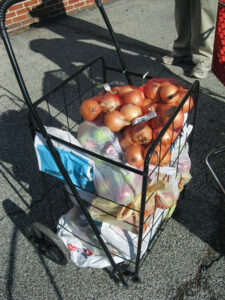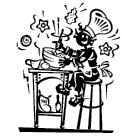
Walking into the refrigerator at Central Illinois Foodbank on a typical day, you’re sure to find food items like onions, potatoes … maybe even some apples. This is great news for the Foodbank’s partner agencies. When asked what they like to see in stock at the Foodbank, fresh produce is high on the list.
At the Foodbank, a shift is happening. Over the past four years, the organization has worked to provide fresh produce to agencies throughout the year, not just during the summer growing season. Sometimes this means trucking in a load of potatoes from Texas, and sometimes it means working with local gardeners, farmers’ market producers and different community garden projects to have these fresh items available.
Distribution increased from 95,000 pounds of produce in 2009 to a remarkable 1.5 million pounds in 2012. “We want our partner agencies and those they serve to have access to these fresh, nutritious items twelve months a year,” said Foodbank Executive Director Pam Molitoris. “We’ve made it a top priority.”
Both national and local efforts have contributed to this increase, but a unique initiative that helps regionally is the Plant a Row for the Hungry program. Plant A Row was started in 1994 through the Garden Writers Association of America with the goal of having home gardeners intentionally plant extra food to send to the local food bank.

Plant a Row for the Hungry (PAR) works through the University of Illinois Extension in coordination with the Master Gardener program, although not all participants are required to be a certified Master Gardener. Participants of PAR volunteer to collect vendors’ produce for the Foodbank at area farmers’ markets. Some vendors grow excess specifically for donation, and some just pass along whatever items won’t make it to the next market. Here in Illinois, PAR projects are under way in Kenilworth, Naperville, Peoria, Riverside, South Elgin, Springfield, Sycamore, Rockford and Urbana to name just a few.
Along with their commitment to collecting donations at the farmers’ markets, the Master Gardeners are also a resource to the community on gardening best practices. These individuals can educate and assist with garden projects, as they are skilled in everything from garden planning to soil testing to harvest times.
Judy Taylor is the Sangamon County Plant a Row program Chairperson, and has been for the past three years. A retired SIU Department of Neurology employee, she enjoys getting her hands dirty and helping give back to the community. When reflecting on the program, she said, “During these hard economic times, it’s so wonderful to see all of the community garden projects that have started in the past few years.”
One of these community gardens is located at the Farm Service Agency in Springfield. Each year this garden has produced thousands of pounds of produce, 100 percent of which is donated to the Foodbank. Each year the garden produces more thanks to the volunteer efforts of office members, Master Gardener volunteers like Taylor, and students from the FFA and 4H Clubs.
In 2012, the Farm Service garden produced more than 15,000 pounds of produce, ranging from tomatoes to turnips. A true community effort, the office’s friendly neighbors helped water the plot during those hot summer months when there was no rain. Volunteers worked in temperatures hot and cold, knowing their efforts were truly making a difference for hungry families. The project won a Governor’s Hometown Award in 2011.
When produce comes from gardens like the Farm Service project and makes its way to the Foodbank, it doesn’t stop there. Agencies who receive fresh items at the Foodbank also get recipe ideas to accompany the produce. Anyone unfamiliar with how to prepare fresh items like squash, turnips or sweet potatoes can get ideas on how to use these nutritious fruits and vegetables at home.

Sometimes, at mobile pantry food distributions, an employee from the Extension office with a food handler’s license will even come and prepare samples with the food being distributed that day. If there are cabbage and carrots, maybe they’ll make a soup or a coleslaw mix for individuals to try while waiting in line. This encourages the sharing of recipe ideas between volunteers and those receiving food, often times between people of different generations.
At the end of the day, the collective efforts throughout the Foodbank’s network make a lasting, impactful change in the 21 counties it serves. With the need increasing about 40 percent on average over the past three years, it’s difficult to keep up with the ever-growing need. Efforts from gardens, large and small, and the volunteers who devote themselves to helping feed hungry families are making a big difference in their communities.
If you would like to get involved with Central Illinois Foodbank or the PAR program, please visit our website at www.CentralILFoodbank.org or call 217-522-4022. For more information about the PAR program go to www.gardenwriters.org.
 Spicy Sweet Potatoes with Apples
Spicy Sweet Potatoes with Apples
2 large sweet potatoes, peeled and sliced
2 tart apples, peeled and sliced
1 Tbsp. Mrs. Dash Extra Spicy seasoning blend
1-4/-1/3 c. orange juice
1 T. margarine
¼ c. brown sugar
Preheat oven to 400 degrees. Place apples and sweet potatoes in bowl. Lightly grease a 2 qt. casserole dish with cooking spray. Mix orange juice, melted margarine, brown sugar and Mrs. Dash in a small bowl. Pour mixture over apples and sweet potatoes. Place in prepared casserole dish and bake covered for 30 minutes. Remove cover and continue cooking for another 15-20 minutes until potatoes are tender and casserole is golden.








